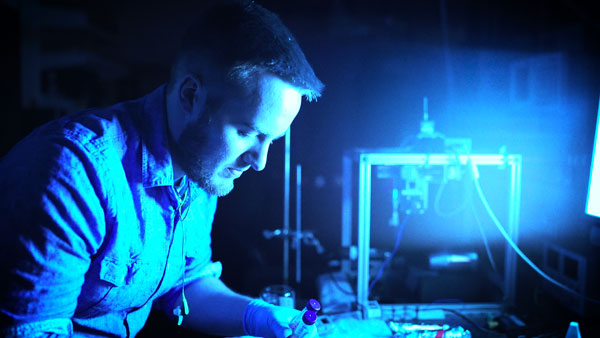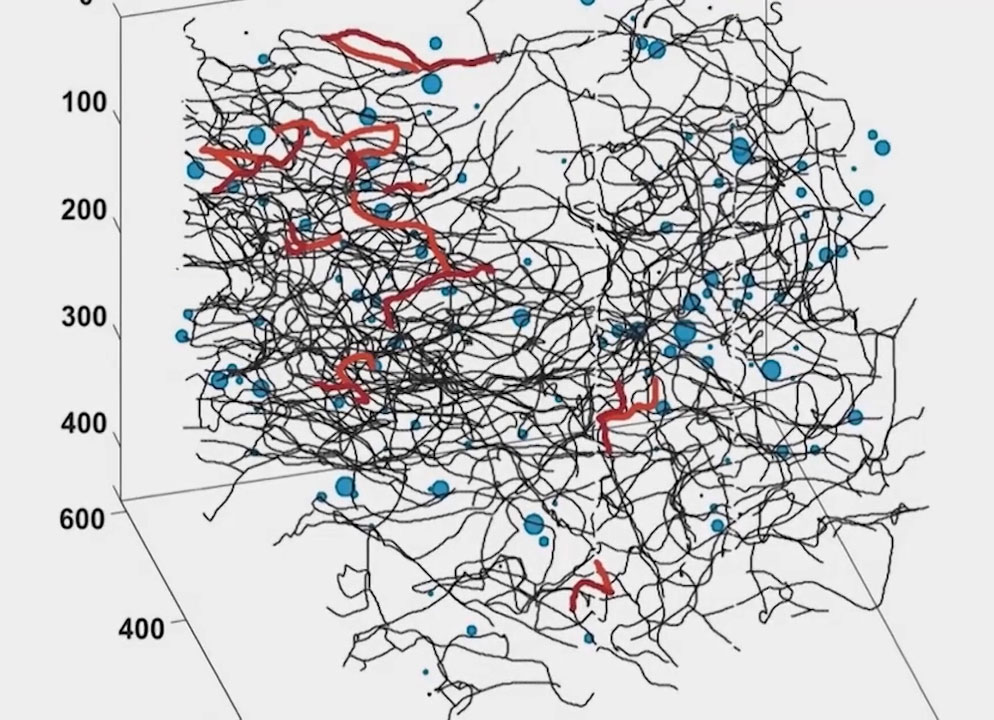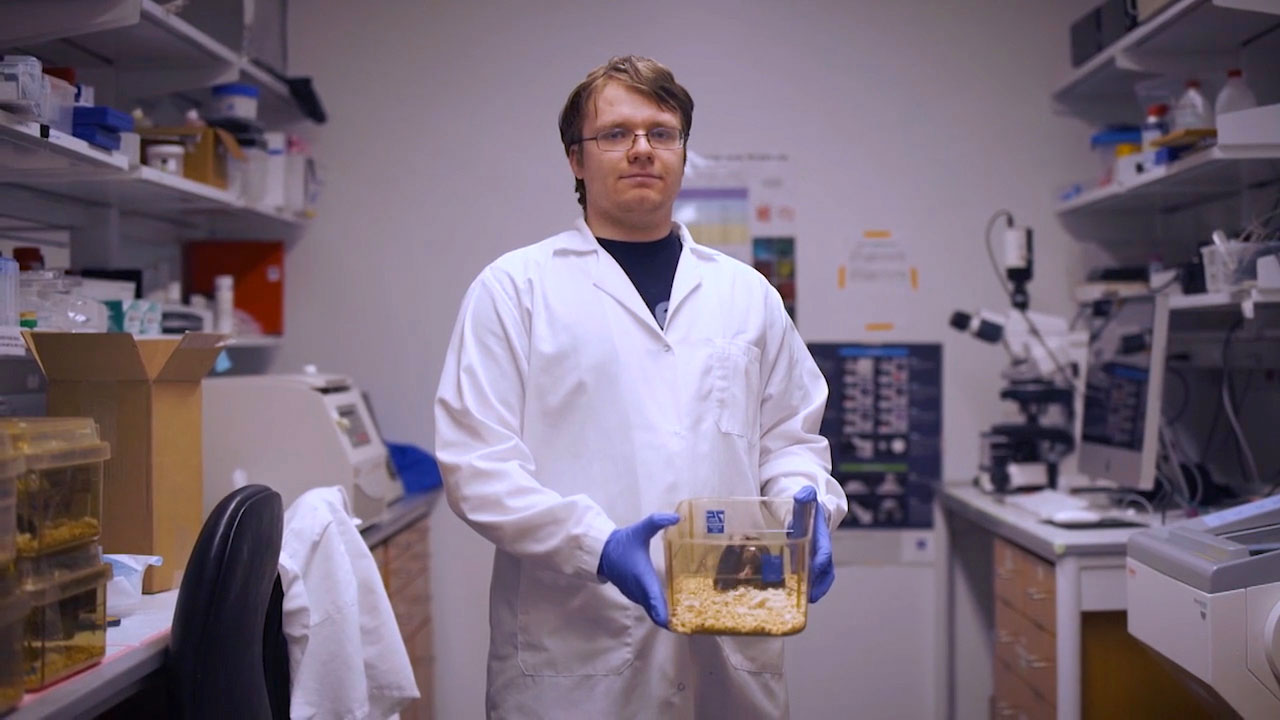
Newsletter
Sign up and stay in-the-know about The Crowd & The Cloud and the world of citizen science.


I'm Nozomi Nishimura, and I'm an assistant professor in biomedical engineering.
Tell us about the essential, core aim of this lab, in terms of Alzheimer's research. What is the importance of being able to see blood flow, and stalled blood flow?
What's challenging about Alzheimer's disease, is it depends on a protein that you make all of your life. There must be something that triggers this abnormal accumulation of Alzheimer's proteins, the same beta protein in some people, and not in others. The mystery was, what is that triggering event? Vasculature, blood vessels, and blood flow is a candidate because it's already changed in patients very, very early on, even before they've had symptoms. To be able to look in a system where you can study the Alzheimer's pathology, and the blood flow was really important, and that was the key for us, being able to look at these other things like blood flow that wasn't directly implicated in Alzheimer's disease, but which turns out has an important effect in the disease.
Can you work with off-the-shelf instruments, or do you pretty much have to build new instruments to do the kind of work that you want to do?
We choose to build new instruments, and what that lets us do is ask or answer questions that no one else has been able to before. Most of our instruments are new types of microscopes, or improvements on microscopy. What having this new technology does is lets us see different anatomy. That means that we can look at structures in the brain, for example, that other people can't look at. The new answers to new questions are very much tied to the new tools.

A student working in the lab at Cornell.
The lasers that you use are pretty much at the heart of things. Describe how the lasers let you travel into the brains of the mice?
What's very important about the lasers is that they're extremely high intensity, and you can arrange it so you get several photons of light that interact with a dye molecule only at one small spot. You can put that spot down at depth in the brain, and then you can map where the light comes from. You know it all came from one small spot because of the way that you arranged the laser light. This builds into an imaging technique because you can then map out, in 3D, all across the brain, and look for where you put the labeling. The labeling can tell you where blood vessels are. In the case of Alzheimer's, they can tell you where the plaques are, and we can also use it to look at different cells.
Stalled capillaries reduces blood flow to 30 percent in Alzheimer’s patients. Tell us about the experiments which are ongoing, that show you can reverse that process.
First, we had to figure out what is making those capillaries plugged. It turns out it's a type of white blood cell, a neutrophil, and these kinds of white blood cells usually react to infections, like a bacterial infection. The white blood cells stick to the blood vessels through certain molecular interactions, and we have found some compounds that interfere with that. Then the white blood cells don't stick to the blood vessels, as well. We've found that does reduce the number of vessels that have plugs in them.

Computer generated image of blood vessels in the brain, with red lines marking stalled vessels.
Then, we also are in the process of measuring what that does for the blood flow into the entire brain, and it looks like it's improving it. In current experiments, we're looking to see how that improves blood flow, overall, to this tissue, and it does look like it improves the blood flow. We have found a way, at least in the experimental models, to improve the blood flow to the point where it is at normal levels. The next step will be to see how that improves in the mice, and hopefully humans.
Tell us about the cascade of events that triggers symptoms of Alzheimer's?
In Alzheimer's disease, we think that reduced blood flow is one of these things that helps trigger the disease, and then also we're finding that the Alzheimer's disease causes the changes in blood flow. That means that once you get any of these things going, it feeds back into itself and makes both the blood flow worse, and the Alzheimer's disease. Our hope, then, if we can improve the blood flow, it'll slow down this whole progression, and perhaps help slow down the whole disease. That would be fantastic, because then you could really delay all the symptoms and really improve the lives of the patients.
Why do you think crowdsourcing is going to answer some of the needs that you, as researchers, have?
It turns out that the human visual system, and human intuition is something that we still haven't been able to mimic in some of the best computing algorithms that we have. To be able to tap into that is really exciting. There are things that you can do by talking to people, by contacting people, that you couldn't do otherwise. For the very specific task that we have, crowdsourcing, this image processing task, it's a matter of the human visual system has evolved to do things that computers cannot.
But I'm also really excited about the idea that, the more people that are thinking about this, that are looking at the data, we never know what human intuition is going to pick up. We'll see what happens, and it really is opening possibilities that we haven’t expected. I'm waiting for the surprises.
Eyewire obviously has a gamer community, but are the demographic of those people that want to be part of this crowdsourcing going to be a lot wider?
Yes, that can be very possible. We have had interest from people that are facing the disease themselves. Certainly, their family members of all ages. And people that never thought they would have been interested in science, for example, are interested because they're related to somebody, or they know somebody that's suffering from the disease. That would be a great way for people to go learn about it, but also see what they can contribute.
What is it about Alzheimer's, as a disease, that makes you want to help?
One of the hardest parts about Alzheimer's disease is, you watch your family, your friends lose their humanity. It takes such a great toll, not just on the person, but on their families and the community around them. That's a contradiction where, on the surface, they seem so healthy because their bodies don't degenerate, it's mostly their minds that degenerate. It's very hard for, the people around them to accept that this person is leaving them, even though they're still there.

A student shows us the mice used for research.
How transferable is it to assume that what triggers Alzheimer's in a mouse is the same process, essentially, as in humans? Why are mice great models for this disease?
Mice are used somewhat for the convenience of having a model that you can work with, you can have them reproduce quickly, and you can have genetic strains. They're not humans, and so we do need to remember that. There's always some barriers. What's really great about this model is that all of the pieces, like the vasculature, the inflammatory system, the neurons themselves, they're all there in these mouse models. If we design things carefully, and look at what the pieces are that come together, we can translate this to humans quite well, but it will take some thought.
In your mind, what would success for EyesOnALZ be?
We're certainly excited about the data that will come out of this, in terms of the images, and the blood vessels that are analyzed, but awareness of how science works will be great. I'm guessing that there'll be some surprises that come out of the data, and they'll hopefully be happy surprises, but the opportunity to share that with the whole community, and the process of discovery is what's really exciting to me.
If everything goes well, we'll know how it works in the mouse models, and we will understand some of the underlying biology. We could start thinking about how we could translate this to humans, and patients.
